 |
|
Would you go to Alaska in this boat? |
||
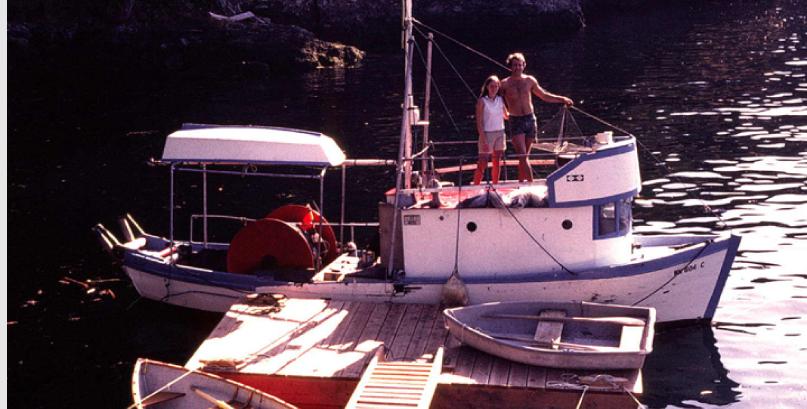 |
||
The winter of 1969-70 found me in the University of Rhode Island Fisheries Program. This wasn’t for biologists or scientists but rather for men who wanted to get a bit more formal training than the traditional way of learning by doing and hopefully working with someone who wanted to teach. We studied hydraulics, diesel mechanics, electrical basics, navigation by stars and buoys, and netmaking. Very hands on, it was mainly focused on improving the skills of young men that were going to become New England draggermen - the business of towing a net along the bottom. Our teacher in Nets and Gear was Burt Hillier, a wiry ‘Newfie’ - Newfoundlander - who’d grown up in one of the remote fishing settlements along the south coast of that rugged island. His father was a cod fishermen, and as a boy too young to go out in the boats, each morning, Burt and his siblings would set out the split codfish to dry on wide, flat platforms, placed head to tail to maximise space, and gathered and covered in the evening and if rain threatened. And when the monthly steamer came, salted down and sold for 24$ a barrel. About the third day of class, he learned that I wasn’t from a fishing family and that indeed, I had never even been dragging. “Why, laddie,” said he to me in that peculiar Newfie twang, “we be going now... and get ye some supper.” And with that we marched out the door to the dock outside and into a beamy wooden outboard powered 18 foot skiff. A hundred yards from the dock we put out this net that seemed no bigger than a painter’s tarp into the water attached to two pieces of wood each the size of half a card table, with a 3/4 inch length of line attached to the whole mess, and motored away. When the line became tight, Burt throttled up, and we began moving slowly through the water. “Now ye see, laddie,” Burt explained over the beat of the motor at half throttle, and waving back at the commotion behind us, clearly seen in the shallow water, “them wood rigs we call doors, and they spread the net, don’t ye know, and that net, it just scoops up what be swimming along.” After about five minutes of very pleasant chatter about life as a young man in Newfoundland, Burt stopped the motor, and we pulled back on the towline until the net came to the surface with half a five gallon bucket of very surprised crabs, a few rusty cans, some ugly spiny fish Burt called Irish Lords, and half a dozen nice dinner plate sized flounder, or dabs as he called them. And just like that I got my supper and intoduction in miniature to what was then the primary way of catching fish across the world. For the next six months Burt and the other instructors would explain in depth the many mechanical systems that kept modern fishing vessels going and especially how to fashion the sophisticated funnel-shaped trawl nets out of flat pieces of netting. |
||||||||||||||||||
Would you go to Alaska in this boat? I tried but engine problems stopped me from even crossing the border into Canada. Had I done so, I probably wouldn't have lived to tell about it... |
||||||||||||||||||
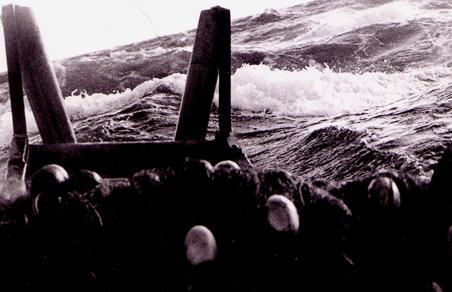 |
||||||||||||||||||
In the tide rip at Point Wilson - the rough seas started a leak in that tired wooden boat that the pumps could hardly keep up with. And Alaska was still over 500 miles away! |
||||||||||||||||||
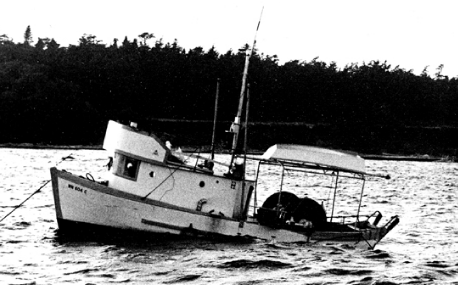 |
||||||||||||||||||
Denise in Mackaye Harbor with her stern full of water after springing a bad leak in the tide rips off Point Wilson. |
||||||||||||||||||
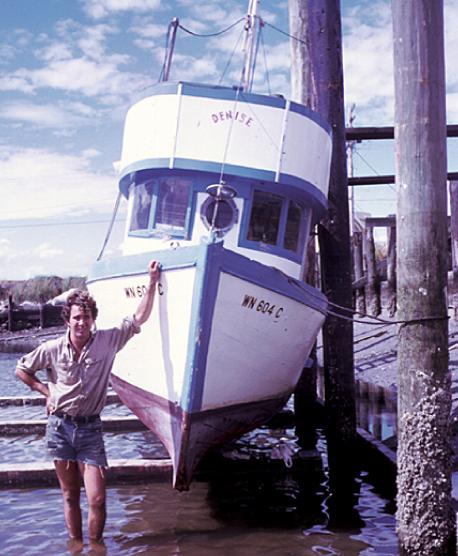 |
||||||||||||||||||
If you forgot to bring your all important pocket knife to class, Burt would admonish us. But in that modest classroom overlooking the harbor and Narragansett Bay, Burt, and another instructor, local draggerman Jim McAuley, showed us the art of using net needles and the knots and terminology of the netmaker: lacing up a bad tear just to get the gear back in the water, then when there was time, cutting carefully back to undamaged netting and then creating with the net needle, the web that was missing. |
||||||||||||||||||
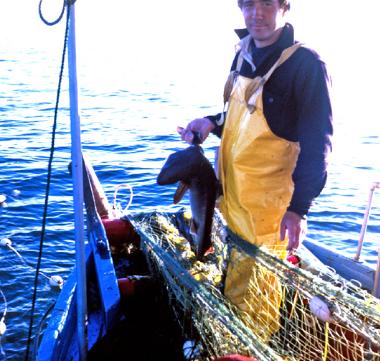 |
||||||||||||||||||
In Fishing School (The University of Rhode Island Commercial Fisheries Program) they taught us nets, navigation, electronics, engine maintainence. But there was no course in how to spot an unsafe boat... |
||||||||||||||||||
Why is this man smiling? Not because he's catching salmon - that's a dogfish... Probably because he's just so glad to have his net in the water after the struggles of just getting out of Seattle! |
||||||||||||||||||
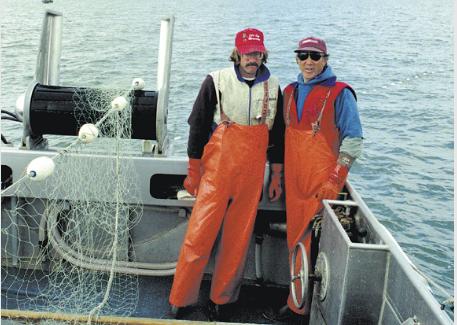 |
||||||||||||||||||
Right - this is what a real, professional gillnetter looks like: me and my brother George, aboard our gillnetter, Bristol Bay, AK, 1993 |
||||||||||||||||||
Most of my classmates were sons of East Coast fishermen, headed back to join their fathers in small coastal communities from New Jersey to Northern Maine. But there was one guy there, Dave Kennedy, who had gillnetted in Southeast Alaska, and in the evenings would often talk with me about the summers he and his wife had up there. It resonated with me - up in the wilderness with your own boat, fishing three or four days a week and having the rest to explore, beachcomb, work on your net, and just hang out in that vast Alaska wilderness. Then one day me mentioned that after school was out he wanted to head down to the Gulf of Mexico and try and see if he could get a job as skipper on a shrimp boat, and that possibly he might be able to lease his Alaska gillnetter, tied up in Seattle for the winter, to me. WOW! Talk about electric words. I couldn’t believe my luck: me headed up to Alaska in my own (leased) boat. Thrilling was way too modest a word for the way I felt when I drove home through the snow from one of those evening meetings with Dave. He had some charts, and we’d talk and he’d mark on the chart where the Inside Passage wound through the islands, and show me where the good fishing places were, and where he and his wife had set up a little camp on the shore. He didn’t have any photos - this was before the days when everyone had a cellphone with a camera - but he sketched out the Denise to me in detail - she looked like a husky 36 or 38 footer with a nice big flying bridge where my girlfriend and I could sit talking and drinking wine as we cruised up the gorgeous winding channels of the inside passage. Life was great as I packed up my tools and gear and got on the plane to Seattle the day after fishing school was over. Luckily I had a friend who lived just a half mile walk away from Seattle’s legendary Fishermen’s Terminal, where much of the Alaska fleet tied up in the winter. And so on a warm late May afternoon, I walked down dock six, toolbox in hand, about as excited as a young man could be. On both sides were rugged handsome gillnetters like the Denise, busy as their owners finished preparing them for a long season in the magic NORTH!! My daydreaming ended at slip 17. What lay there, unkempt, low in the water, listing to one side, paint chipped, tattered and sad, was more like a kid’s drawing of a boat than a real Alaska fishing boat. At first I was sure there was some mistake; David who was a big man, easily 40 pounds on my 180, couldn’t have gone to Alaska with his wife in that.... thing. My dream had been of a 35 footer, which seemed to get bigger the more I thought about it. This thing was barely 26. Then I walked out to the end of the dock finger to where I could see the name: Denise. She was mine, allright.. I put down my toolbox with a thud, and leaned heavily against the dock piling. “Hey, Kid....” I looked up. A rough looking guy working on the very nice boat in the next slip was staring over at me, a wrench in his hand and what looked like a hydraulic valve in pieces on a sheet of clean cardboard on the hatch cover. “You’re not thinking of taking that piece of dogshit to Alaska, are ya...?” “Well...” I stammered, totally stunned at the unexpected turn of events, “well.. I guess I was..” He put down his wrench and looked me up and down, finally shaking his head. “I wouldn’t let my kid swim off that boat...” I should have taken that guy's advice; should have walked away. The whole Alaska salmon fleet was gearing up, my old boss was around, I’d been to fishing school, I could have gotten a job on a really good boat; my life would have been so different.. But although fishing school taught me three or four ways to find my position, how to change diesel injectors, build nets, troubleshoot electronics, there was no course in common sense, no information on when to walk away from a doomed project. Instead, I plunged into it, dawn to dusk, enlisted friends, hauled the engine, hired a mechanic to rebuild it in a friend’s garage, painted, rewired, replumbed, rerigged, spent all my money, borrowed more and more after that. And finally... one fair June afternoon all was almost ready. Just had to do a test drive with the rebuilt engine - it had run fine at the dock but we really needed to go out and run it hard. I’d buy my groceries that night, I’d found some other boats to travel with - my girfriend, wisely had decided against the trip up - and in the morning I’d be off at last. We left the dock, idled through the ship canal to wide Lake Union, four or five hundred acres of water just north of downtown Seattle. The mechanic who’d rebuilt the engine adjusted the carburetor, and told me to go ahead and throttle up. And didn’t that puppy sound great! The stern settled a little lower, the bow lifted, it was like that boat just wanted to go north! I would feel the excitement building in me as well. We gave her full throttle for a good ten minutes, to let everything get up to operating temperature. With an odd clank, the engine stopped dead. It took us a moment to realise what had happened: it had thrown a rod - a connecting rod, the steel piece that connected one of the pistons to the crankshaft. It had had come loose, and was sticking out of the side of the steel engine block. Then engine was totally ruined. Then we noticed that the boat was on fire as well, where the poorly insulated exhaust pipe went through the roof of the cabin. We put out the fire, and just sat there for a long moment, waiting for a tow. We broke out the nice case of beer that I had bought to celebrate. Then the mechanic turned to me, “You know,” he said, totally without guile, “the other one I rebuilt did that too...” I could have strangled him. My money was almost gone. We found another engine, used but serviceable. “Plenty of good life left in her,” her owner had assured me. But when I got it all installed, I discovered that the rear seal, sort of a rubber ring around the crankshaft where it comes through the back of the engine, was bad. So it leaked oil. A lot of oil, like a quart an hour. I couldn’t face taking another engine apart, so I bought six five-gallon buckets of recycled oil, put them in the fish hold, and finally, finally, headed out into Puget Sound, the beginning of the Inside Passage, against the advice of family and friends. When the big gates of Seattle’s Ballard Locks opened up before me, the day had been pleasant, the wind light, the day so fair. The first leg of our journey was smooth, but anxious. I looked for leaks, monitored the engine, and watched and listened for whatever flaws the Denise might still be hiding. At Point No Point Lighthouse, a marker on a low, driftwood covered spit twenty miles north of Seattle, I began to breathe a little easier. Aside from the hourly ritual of adding oil to the engine, things seemed to be running more or less smoothly, and I began to think of my route, of where I might spend the night, and of those who had traveled before me. In the early afternoon, we came to Point Wilson where the sheltered waters of Puget Sound become the much wider waters of Juan de Fuca Strait, which separates the US from Canada. As we nosed out into the Strait, on the first leg of our 600 mile trip up the Inside Passage to Alaska, I felt like the Klondikers of almost a century before, crowding the rail of their Alaska bound steamers, watching the familiar country fall away, watching the raw, new vistas opening up ahead. I was going to Alaska! The western end of the Strait is the North Pacific Ocean, and on many days, as the vast body of land to the east heats up in the afternoon, a westerly breeze sets in as all that air is drawn in from the ocean. The westerly pushes against the confused tidal currents in the Point Wilson area and creates a wide area of rough, confused water, where seas seem to come from every direction. Good sized boats had been lost there. That day was no different. We got into a tide rip and I felt the cold metallic taste of fear rising in my throat. The little Denise was pushed one way and then another. The sky clouded over and the tide raised a short, mean chop through which we struggled. Two red lights came on in the instrument panel - the bilge pumps - and stayed on. They can pump a lot of water, and usually just blink on for maybe 20 seconds and then go off. But this time they stayed on - a lot of water was leaking in somewhere, but there was no way of telling if the pumps were keeping up or not - there was no autopilot like bigger boats have and I couldn’t leave the wheel long enough to see where the water was coming from. Again and again the Denise plunged into the trough of a big sea, shaking and rattling everything aboard. The engine began to run rough, and there was the faintly nauseating smell of gasoline, oil, and filthy bilge water. A little distance away, I could see one of the bigger boats that had been moored near me at Fishermens Terminal. She seemed to be traveling easily through the tide rip, barely wetting her windows, while the little Denise was fighting for her life. A few hours later, I made the San Juan Islands, and limped into the protection of Mackaye Harbor away from the powerful westerly that was booming up the Strait outside. I dropped the anchor, shut off the engine, dug out the rum bottle, poured myself a stiff one, and sat out on deck. Just a hundred yards away gusts of wind were darkening the water. Now that we were out of the rough water, the pumps were finally starting to gain, but we were low in the water from all that had leaked in. One thing now was abundantly clear: to take the Denise north would be suicide. My grandly framed Alaska plans would have to be put away for another year.. I ended up fishing in the very northern tip of Washington, a place called Boundary Bay. Fish bound for Canada’s Fraser River would sometimes eddy down into US waters there, and if it was foggy, we might even sneak over the border to get a few more. I called it retirement fishing - it was sunny and warm, and most of the other fellows were longshoremen, for whom summer gillnetting was more like a long boozy vacation with their buddies. And the talk was of Alaska. Some had fished there before and wanted to go back. The rest wanted to go. It broke my heart to listen to their stories. |
||